14.214.460 Service Areas and Mechanical Equipment.
A. Purpose.
1. To minimize adverse view, odor, fume, and noise impacts of mechanical equipment, utility cabinets, and other service areas at ground level and on roofs.
2. To provide adequate, durable, well-maintained, and accessible service and equipment areas.
3. To protect residential uses and adjacent properties from negative impacts due to location and utilization of service areas.
B. Location of Ground-Related Service Areas and Mechanical Equipment. Building service areas and mechanical equipment include loading docks, trash collection and compactors, dumpster areas, storage tanks, electrical panels, HVAC equipment, wireless communication facilities and other utility equipment. Wherever possible, these elements should be contained within the building envelope or on roofs and screened so they are not visible to the public.
If any service areas and utility mechanical are outside the building envelope at ground level, the following location standards apply:
1. Service areas shall be located for convenient service access and shall be screened from public rights-of-way, parking areas, pedestrian areas, and adjacent properties with the structural and landscape screening measures provided in subsection C of this section.
2. Service areas for multiple users or tenants shall be co-located or consolidated to the extent practical.
3. Service areas shall be sited for alley access if available. Service elements accessible from an alley are exempt from the screening requirements of this section.
4. All service areas, including trash collection areas, shall include roofs or overhead weather protection and shall meet applicable stormwater standards, as determined by the City Engineer.
5. Exterior loading areas for commercial uses shall not be located within twenty (20) feet of a single-family zoned property, unless there is no viable alternative. Loading areas allowed within twenty (20) feet of a single-family zone must be separated by a masonry wall at least eight (8) feet in height. Noise studies may be required by the Planning Director as part of the permitting review process.
6. Service areas used by residents shall be located to avoid entrapment areas and other conditions where personal security is a concern. Pedestrian-scaled lighting or other measures may be required by the Planning Director to enhance security.
7. Noise-producing mechanical equipment such as fans, heat pumps, etc., shall be located or shielded to minimize sounds and reduce impacts to adjacent dwelling units.
8. Dumpster storage areas shall be provided for all nonresidential developments and mixed-use or residential developments containing at least ten (10) residential units. Dumpster storage areas shall be located on the site they serve, and shall not be located in the public right-of-way.
C. Where ground level service areas are necessary, they shall be screened with the following provisions:
1. Structural enclosures shall be constructed of masonry, heavy-gauge metal, heavy timber, or other decay-resistant material that is consistent with the architecture of the main building. Alternative materials other than those used for the main building are permitted if the finishes are similar in color and texture or if the proposed enclosure materials are more durable than those for the main structure. The walls shall be sufficient to provide full screening from the adjacent street, pedestrian areas or uses, but shall be no greater than seven (7) feet tall. The enclosure may use overlapping walls as a screening method. See Figure 11.
2. Gates shall be made of heavy-gauge, site-obscuring material. Chain link or chain link with slats shall not be permitted for enclosures or gates.
3. Where the interior of a service enclosure is visible from surrounding streets, pathways, or residential units, an opaque or semi-opaque horizontal cover or screen shall be used to mitigate views. The horizontal screen/cover should be integrated into the enclosure design.
4. Garbage collection points shall be located and configured so that the enclosure gate swing does not obstruct pedestrian or vehicular traffic, and does not require that a hauling truck project into any public right-of-way. Screening elements shall allow for efficient service delivery and removal operations.
5. The ground surface of the service area shall be paved.
6. Landscaping shall be provided at the sides and rear of service enclosures if they are visible from the street, parking lots, and pathways to soften views and add visual interest.
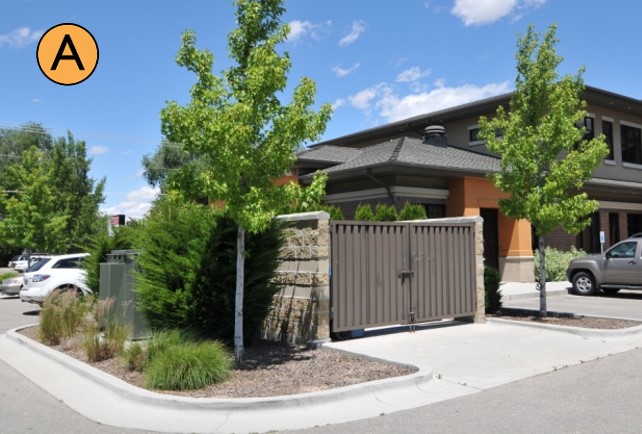
|
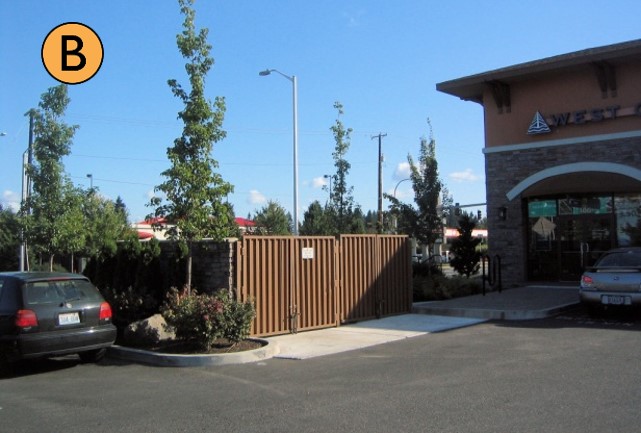
|
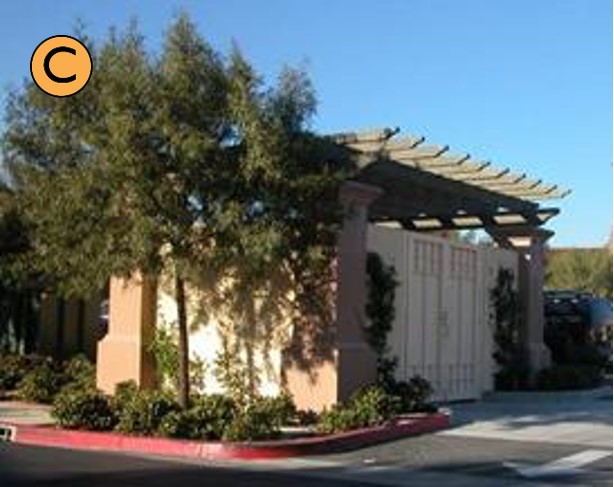
|
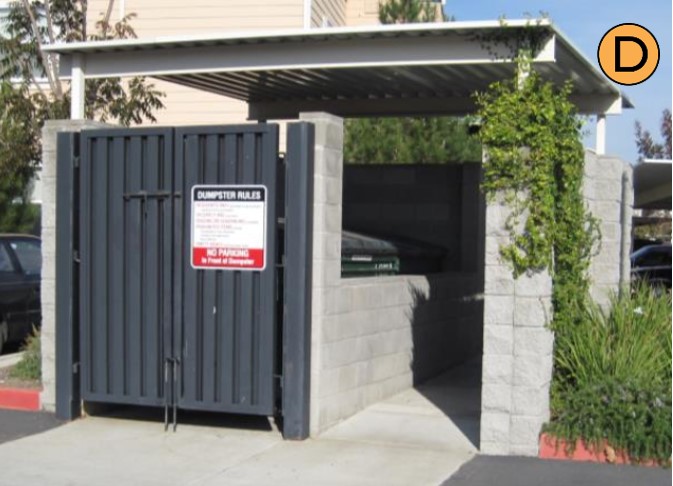
|
|
All examples use durable enclosures with trees and shrubs to soften views of the enclosures from the side. Images C and D use a trellis and weather protection structure on top – a desirable feature particularly where the top of the enclosures are visible from surrounding buildings, streets, and pathways (due to topography or building heights). |
|
D. Utility Meters, Electrical Conduit, and Other Service Utility Apparatus. These elements shall be located and/or designed to minimize their visibility to the public. If such elements are mounted in a location visible from the street, pedestrian pathway, common outdoor recreation area, or shared auto courtyards, they shall be screened with vegetation and/or integrated into the building’s architecture.

|
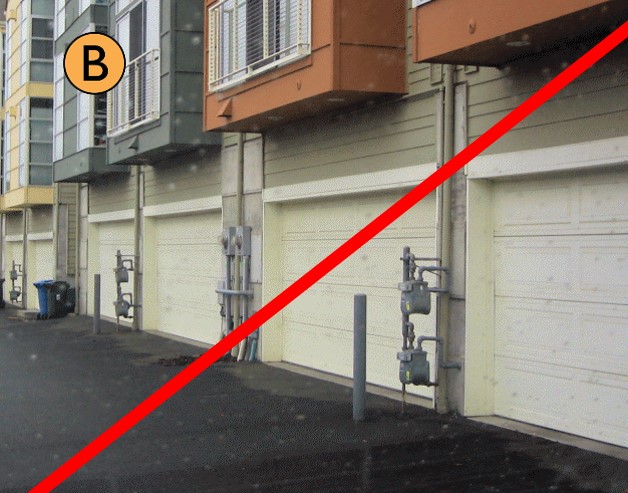
|
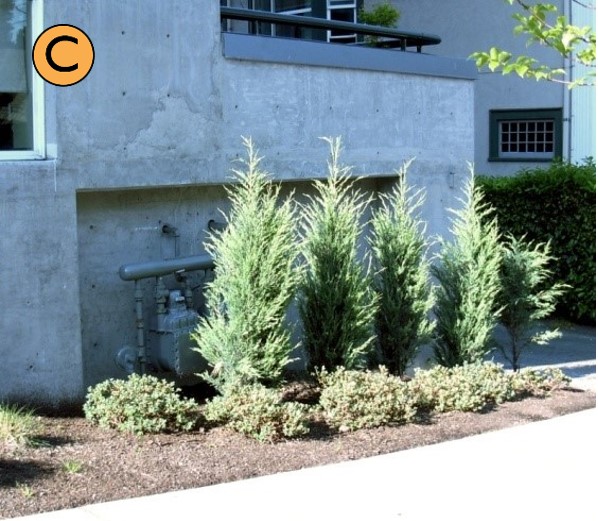
|
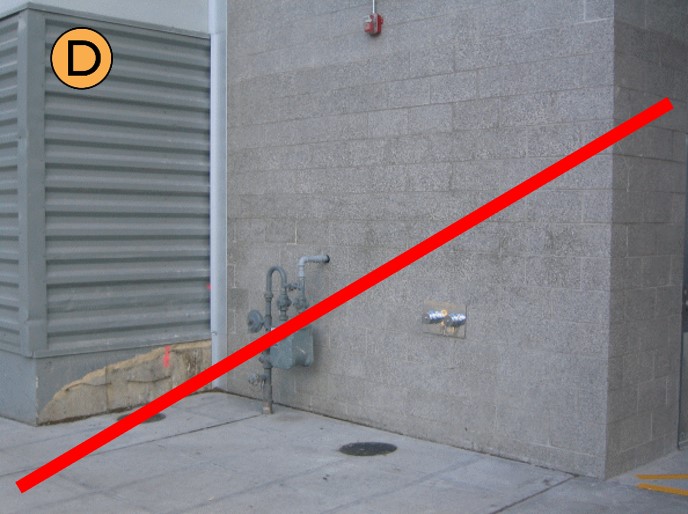
|
|
Images A and C are tucked away in a less visible location and/or screened by vegetation. Images B and D are poorly executed and would not be permitted in such visible locations. Such meters shall be coordinated and integrated with the architecture of the building. |
|
E. Roof-mounted Mechanical Equipment. All rooftop mechanical equipment, including air conditioners, heaters, vents, wireless telecommunication facilities and similar equipment, shall be fully screened from public view at the street level. Screening shall be located so as not to interfere with operation of the equipment.
Exception: Roof-mounted wind turbines, solar energy and photovoltaic systems, and rainwater reuse systems do not require screening.
F. All rooftop screening devices shall be integrated into the architectural design of the building through such elements as parapet walls, false roofs, roof wells, clerestories, or equipment rooms. Screening walls or unit-mounted screening is allowed. Louvered designs are acceptable if consistent with building design style.
G. The screening method shall be constructed of materials requiring minimal maintenance and shall be at least as high as the equipment being screened. Wood and perforated metal are not permitted materials for screens or enclosures.
H. Noise-producing mechanical equipment such as fans, heat pumps, etc., shall be located and/or shielded to minimize sounds and reduce impacts to adjacent properties.
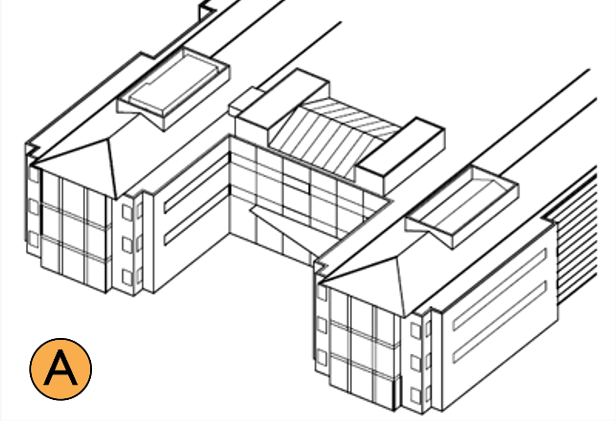
|
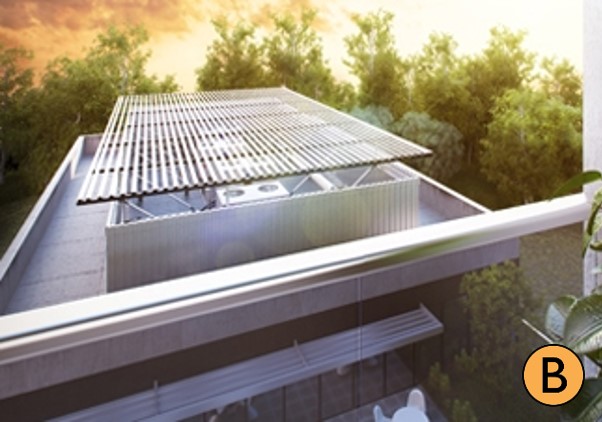
|
|
Illustration A shows how rooftop mechanical equipment can be located and screened effectively. Image B shows effective location and screening, including side walls and a trellis to screen views from taller surrounding buildings. |
|
(Ord. 2425, 2022)